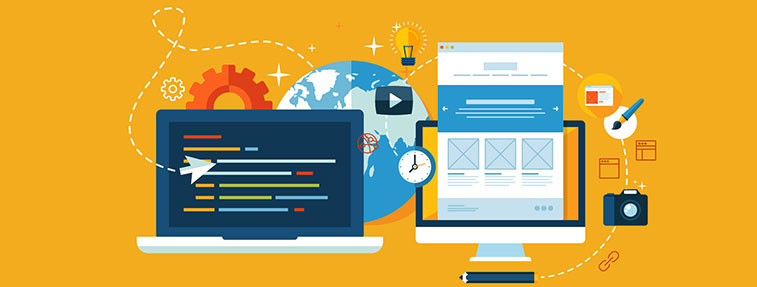Key Components of an Effective Landing Page
Web designers, developers, and programmers are trained and proficient to design and develop websites. They have in-depth skills and knowledge of the technical side of how websites are built. However, a marketing skill is required to execute an effective landing page.
Most of us hear the term landing page, but often times we confused it with a home page. A landing page, from the name itself, is a page where online users land on, mostly by clicking a link from another website. For example, you are reading an article about “The Importance of Landing Pages”, and in that article, there’s an ad that says “Optimize your Landing Page, Learn more here “when you clicked on that ad, the page that you will land on is called a landing page.
A typical landing page has a call to action, a contact form, the benefits of your offer, social proof and many more. While it’s important to note that even if all these are present in your landing page, your execution will determine the success of your page. For example, you may have a call to action button, but if your choice of words and your button design don’t work well with the overall layout of your page, you won’t get much attention.
To craft an effective landing page, here are 6 key elements your landing page must have:
- An Effective Landing Page Has a Unique Selling Proposition (Benefits and Features)

Any product or service must have a unique selling proposition. What makes your product and services different from your competitors? Why would people buy your products and avail of your services instead of your competitors?
Just look around you especially at malls. How many clothing retailers are there? How many shoe stores are there? How many sells the same food concept at the food court—pizza, spaghetti, fried chicken?
Almost all businesses today have no originality. This is the main reason why most landing pages don’t work. Because most of them lack innovation, most of them are bland, dull, and boring. Understand that people have heard it before, people have seen it before.
Your unique selling proposition is specific to your products and services. It’s important to note that crafting your USP requires heavy research and creativity. It involves in depth analysis of your competitors, your market, and your environment.
To better understand, here are some of the simplest and most effective USP from top notch companies worldwide:
FedEx Corporation
When it absolutely, positively has to be there overnight.Domino’s Pizza
You get fresh, hot pizza delivered to your door in 30 minutes or less or it’s free.Avis
We’re number two. We try harder.Notice how these unique selling propositions belong only to these companies? Name other pizza restaurant with delivery service that offer free food if delivery time exceeds 30 minutes. Name another company who’s currently at number 2 and admitted that they are only number 2 in the marketplace?
But, how do you create an effective unique selling proposition?
List all the benefits and features of your product and services. Out of all those list, choose the simplest one and work around a compelling copy that will tickle your online visitors’ bones. When producing an effective copy, a cardinal rule is to keep it short and simple.
Here is an example of our company’s unique selling proposition:
- Guaranteed 100% money back if you are not satisfied with the designs.
- Unlimited design revisions
Pretty unique huh?
- An Effective Landing Page Defines your offers in a clear and simple manner.

Because most business owners are passionate about their products and services, they want to squeeze in as many features, benefits, and advantages of their products and services on their landing page. Have you ever visited a site with at least 10 rotating banners that specifically highlight each benefit and advantage of their offer? It becomes too obvious that the owner is trying too hard.
The question is, what are you selling? How can it benefit users? If your landing page fails to answer these two questions, then your users will hit the back button.
Statistics show that users form an opinion about your website within 5 seconds time and within 3 seconds time, users must be able to understand and figure out what your page is all about, otherwise they will hit the back button.
There’s a test known as the five second test. In this test, website owners will show a portion of their website to a number of people for five seconds. Then, participants of the test are asked what they recall from the web page. Because first impression is vital when it comes to your website, business owners employ this technique to analyze what part of their web content works and what doesn’t.
To get an idea, here are some examples of simple and effective landing pages:
Industrial strength marketing. It says on their landing page, “Don’t Make Me Zoom.” Just by reading this headline, users immediately understand that this company specializes in some type of responsive design aspect of web development. Just below the headline, a subtext says “7 Reasons Industrials and B2Bs Need Responsive Websites” Instantly, users understand what the company is all about. This is an effective landing page because within seconds, users are able to comprehend what the company is offering.
Shopify. On their landing page is a list of benefits that is clearly stated in bullet points. Because people today are so impatient, it’s important to remember that website content is not read, they are scanned. By employing bullet points, users can easily read your landing page and understand what will benefit them if they choose to take action on your landing page.
Bills.com in my opinion any company that specializes in number is quite boring. But if you are welcomed with a headline that says “Are you behind on your payment?” there’s a sense of urgency that will trigger your brain to take action. Bills.com’s landing page is able to capture readers’ attention by creating an urgent situation that will lead them to take action.
Remember, your landing page must clearly define and state what your company is all about. Create an urgency. Employ the bullet point technique. Use compelling headline with supportive sub headline.
- An Effective Landing Page Must have Social Proof or Client Testimonials

Nothing beats a good product or a service review. Because people heavily rely on what other people say, your client testimonials play an important role in your landing page. With client testimonials, you increase your credibility online and you are able to showcase your level of expertise to your consumers. Because people will automatically look for reviews about your company, you can provide a comprehensive list, perhaps at least two to three client testimonials from your loyal customers on your landing page. To save your consumers’ time, instead of them browsing through other review sites.
It’s not a landing page, but consider the website Forty One Twenty, on their about us page, they let customers speak for their company. Their customers define what the company is all about. Utilizing this strategy will dramatically improve your landing page getting noticed.
Most people might think testimonials offer little help when it comes to converting your consumers, if you think about it, we all ask the opinion of others. We want to know which shoe shop offers the sturdiest leather shoe, which clothing line offer the best quality, which brand is better? All these are everyday conversation between friends, between consumers.
Equip your landing page with at least two social proof that what you are offering is actually a good deal. Consumers will respond better to this.
- An Effective Landing Page Must Have Engaging CTAs

Calls to action is very effective and is one of the elements every website should have. It’s not just a website element you can decide whether to implement them on your site or not. It’s a must that you have a call to action. By definition, call to action is designed to elicit an immediate response from your consumers. Without a call to action, your consumer won’t know what to do. You may provide a comprehensive knowledge of your products and services but without having some type of instruction your consumers they won’t know what to do with your offer.
Common call to actions most companies utilize include download now, subscribe now, add to cart, sign up, and many more. With these instructions, you give consumers direction on what you want to achieve with your offer. By utilizing them, you trigger your consumer to buy or to take action on your offer.
Notice how most websites have call to action buttons on every page of their site? While it’s only a small button, it can create a huge difference in the marketplace. Arguably the most important element of your site, call to action buttons must be crafted creatively. Choice of words and the overall design of the button will determine how effective your call to action is.
Check out Dropbox. Its simple Sign Up call to action works perfectly well with the overall layout of the web design. Known for its minimalist design, Dropbox takes advantage of white spaces and only uses the soft hue of blue to accentuate its call to action. With the only colored button on the site, consumers will instantly notice these buttons.
Another great example is Netflix. We all fear subscribing to something that later on we can longer unsubscribe from. By identifying this consumer problem, Netflix assures the people that they can cancel anytime. The fear was removed. As a result more people will be encouraged to sign up on their channel. Focusing mainly on choice of words, Netflix is able to capture the attention of its target market.
Remember, we all have our own trigger words that will impact our buying decisions. Conduct a thorough study that will help you understand which trigger words your target market will respond significantly. And don’t forget, your call to action relies on the design as much as it relies on your chosen words. Both should balance each other out.
- An Effective Landing Page provides compelling information that grabs attention

Without substance, your content will not attract your readers. Start with a compelling headline.
Crafting a catchy headline is an essential part of your landing page. An effective headline grabs your readers’ attention. Its function is to let readers read the first sentence of your copy. The headline alone is too much of an effort to read, what more of the whole body of your content?
There are four elements to consider when crafting an effective headline:
- It must should be unique.
- It must be ultra-specific.
- It must convey urgency.
- It must be useful.
While all these are important you don’t necessarily have to apply all of them on your headline. One or two should be enough.
Similar to unique selling proposition, what makes your headline different from the rest? What makes your headline so different that it will pique your readers’ attention? When it comes to it, it all boils down to your products and services’ benefits and features. What specific feature or benefit that only your product has? Take advantage of these to be able to produce and effective headline.
Like all marketers, we want to create a sense of urgency. Because people are so busy with their work, they won’t have any time to click on the different offers online. You must create a sense of urgency to imply that what you are offering is truly an urgent matter. Of course, if its not useful, people won’t buy your product.
- An Effective Landing Page Must Have an Excellent UX Design

In today’s technology, people heavily rely on excellent user experience. If your landing page is not designed to produce an excellent user experience, consumers won’t bother to scroll through your site. User experience design refers to the overall emotions felt by users when interacting with a particular product or in this case with a particular landing page. An excellent user experience means that our consumers were able to understand your landing page and were able to navigate through the page seamlessly.
Landing pages help you convert your online readers into paying customers. Because you appear everywhere online, if crafted properly, your banner ad will successfully be clicked by an online user. As a result, through your ad, you were able to pull your reader into visiting your site your landing page. As mentioned above, your landing page must list down all the benefits and features of your offer, it must contain engaging calls to action, it must grab your reader’s attention using a compelling information, it must be equipped with social proof, and most importantly it must have an excellent user experience design.
What other key components of an effective landing page can you think of? Share us your thoughts and comment below!